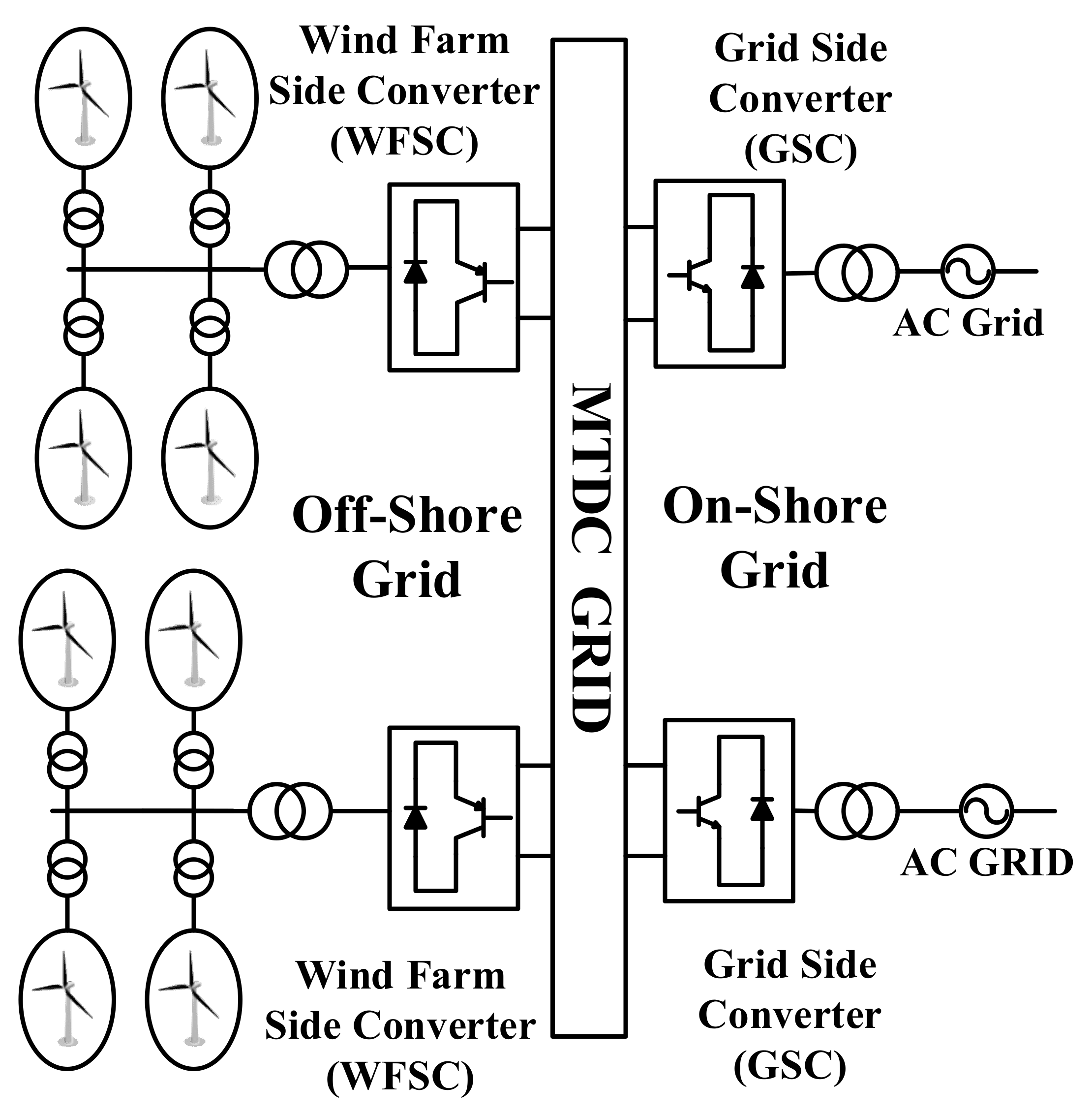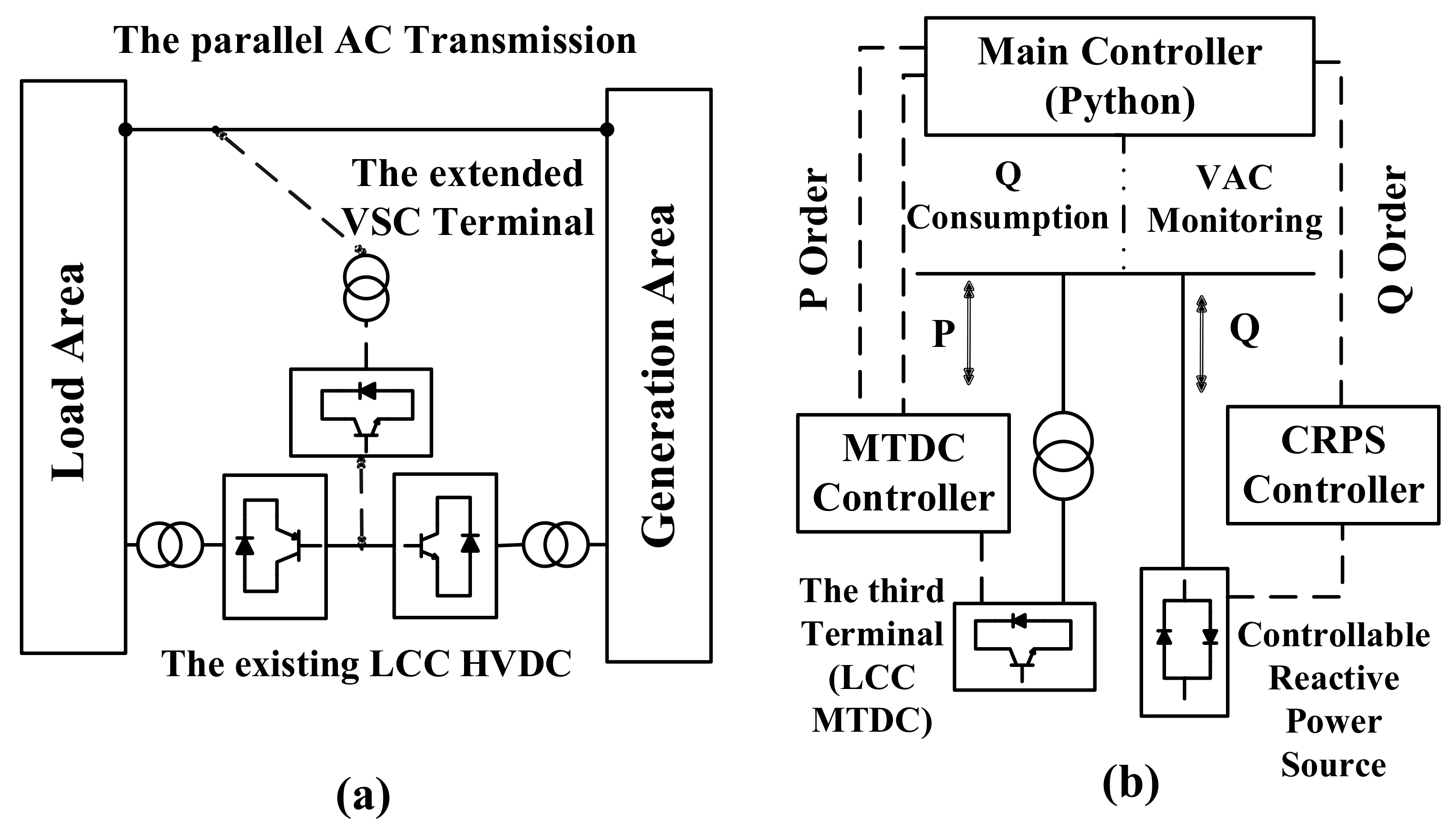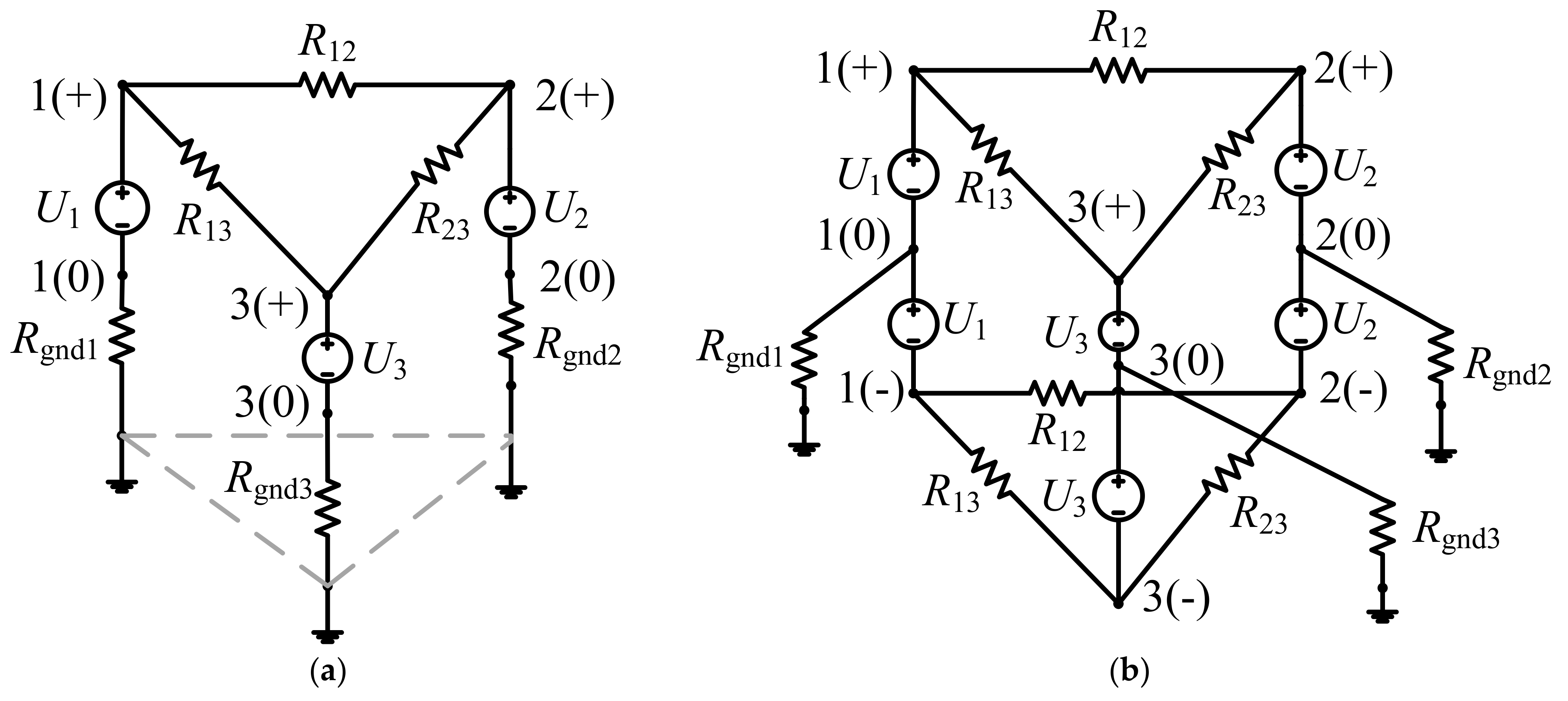
| Version | Summary | Created by | Modification | Content Size | Created at | Operation |
|---|---|---|---|---|---|---|
| 1 | Kuaanan Techato | + 2998 word(s) | 2998 | 2021-09-08 08:06:46 |
Video Upload Options
The concept of hybrid high-voltage alternating current (HVAC) and high-voltage direct current (HVDC) grid systems brings a massive advantage to reduce AC line loading, increased utilization of network infrastructure, and lower operational costs. However, it comes with issues, such as integration challenges, control strategies, optimization control, and security. The combined objectives in hybrid HVAC–HVDC grids are to achieve the fast regulation of DC voltage and frequency, optimal power flow, and stable operation during normal and abnormal conditions.
1. Introduction
The power grids are growing both in terms of complexity and size. The added complexity is due to the regulations that aim to integrate renewable energy systems to make sustainable power systems and due to the increase in efficiency. The advanced energy storage techniques and power electronics technology is also contributing towards making the current high-voltage alternating current (HVAC) grids more complex. The high-voltage direct current (HVDC) systems are becoming equally important due to the involvement of onshore and offshore renewable energy sources, such as solar and wind power, since the output from their AC asynchronous grid system has to be transformed into HVDC for long-distance power transmission. This is because of fewer expenses, increased power transfer capability, and fewer dielectric losses. Therefore, the advanced research is focused on hybrid HVAC–HVDC grids that led to developing improved power transmission capability, introducing back-to-back systems for interconnected regions with different frequencies, and making power transmission systems more efficient for long distances [1].
The complete shift of HVAC grids into HVDC grids is more unlikely due to technical issues, such as power reversal and communication network for coordination between grids, as these problems are not found in HVAC systems [2][3][4]. Therefore, it is more likely that the existing power grids will transform into hybrid HVAC–HVDC systems. The hybrid grids will receive the benefits of both the HVAC and the HVDC systems. It is worth mentioning that these hybrid grids are also facing some major integration challenges related to reliable and adequate modeling of high-speed power converters and protection from large fault currents that have been identified and discussed in this paper [5]. This survey has highlighted the control strategies and optimization algorithms for fast, accurate, and robust control of generation, power-flow, supervisory, and contingency of hybrid HVAC–HVDC grids for their normal and abnormal operation. The security of the hybrid power system relevant to physical malfunctioning of power system equipment, line-outage, and contingencies, and various other physical reasons that sources variations and uncertainties in the MTDC networks causing a security breach has also been analyzed in detail for the stable and cost-effective operation of hybrid grids.
Power flow control (PFC) is considered one of the major issues in hybrid systems, which has not been comprehensively addressed earlier. The integration of asynchronous AC systems in multi-terminal direct current (MTDC) networks has also provoked numerous and critical challenges related to DC voltage control, power-sharing, and power flow that restrains the establishment of independent and self-sustaining regulation of active and reactive power conservation and flow [6][7][8][9]. Therefore, appropriate control strategies should be modeled considering the converter (voltage source converter (VSC) or line-commutated converter (LCC)) losses and DC transmission line losses for a fast, accurate, and robust DC voltage regulation [10][11][12]. Moreover, reactive power support is essential for the dispersal and dispatch of a stable, optimal, and instantaneous balanced power in HVDC grids under normal and fault circumstances [13][14]
2. Control Strategies of Hybrid HVAC–HVDC Systems
2.1. Power Flow Control

2.2. Contingency Analysis


2.3. Fault Ride through Control
2.4. Generation Control
2.5. Supervisory Control
3. Conclusions and Recommendations
References
- Jafar, M.; Vaessen, P.; Yanushekvich, A.; Fu, Y.; Marchall, R.; Bosman, T.; Irvine, M.; Yang, Y. Hybrid grid, towards a hybrid ac dc transmission grid. In DNV GL Strategic Research Innovation Position Paper; DNV GL: Bellum, Norway, 2015; Volume 2.
- Ahmed, N.; Haider, A.; Van Hertem, D.; Zhang, L.; Nee, H.-P. Prospects and challenges of future HVDC SuperGrids with modular multilevel converters. In Proceedings of the 14th European Conference on Power Electronics and Applications, Birmingham, UK, 30 August–1 September 2011; pp. 1–10.
- Hong, L.; Zhou, X.; Xia, H.; Liu, Y.; Luo, A. Mechanism and Prevention of Commutation Failure in LCC-HVDC Caused by Sending End AC Faults. IEEE Trans. Power Deliv. 2021, 36, 473–476.
- Xiao, H.; Sun, K.; Pan, J.; Li, Y.; Liu, Y. Review of hybrid HVDC systems combining line communicated converter and voltage source converter. Int. J. Electr. Power Energy Syst. 2021, 129, 106713.
- Korompili, A.; Wu, Q.; Zhao, H. Review of VSC HVDC connection for offshore wind power integration. Renew. Sustain. Energy Rev. 2016, 59, 1405–1414.
- Aragüés-Peñalba, M.; Alvarez, A.E.; Arellano, S.G.; Gomis-Bellmunt, O. Optimal power flow tool for mixed high-voltage alternating current and high-voltage direct current systems for grid integration of large wind power plants. IET Renew. Power Gener. 2015, 9, 876–881.
- Baradar, M.; Ghandhari, M. A Multi-Option Unified Power Flow Approach for Hybrid AC/DC Grids Incorporating Multi-Terminal VSC-HVDC. IEEE Trans. Power Syst. 2013, 28, 2376–2383.
- Li, B.; Wang, W.; Liu, Y.; Li, B.; Wen, W. Research on power flow calculation method of true bipolar VSC-HVDC grids with different operation modes and control strategies. Int. J. Electr. Power Energy Syst. 2021, 126, 106558.
- Altun, T.; Madani, R.; Davoudi, A. Topology-Cognizant Optimal Power Flow in Multi-Terminal DC Grids. IEEE Trans. Power Syst. 2021, 36, 4588–4598.
- González-Cabrera, N.; Castro, L.M.; Gutiérrez-Alcaraz, G.; Tovar-Hernandez, J.H. Alternative approach for efficient OPF calculations in hybrid AC/DC power grids with VSC-HVDC systems based on shift factors. Int. J. Electr. Power Energy Syst. 2021, 124, 106395.
- Nguyen, T.-T.; Son, H.-I.; Kim, H.-M. Estimating Stability of MTDC Systems with Different Control Strategy. J. Electr. Eng. Technol. 2015, 10, 443–451.
- Prieto-Araujo, E.; Bianchi, F.D.; Junyent-Ferre, A.; Gomis-Bellmunt, O. Methodology for Droop Control Dynamic Analysis of Multiterminal VSC-HVDC Grids for Offshore Wind Farms. IEEE Trans. Power Deliv. 2011, 26, 2476–2485.
- Xu, L.; Yao, L. DC voltage control and power dispatch of a multi-terminal HVDC system for integrating large offshore wind farms. IET Renew. Power Gener. 2011, 5, 223–233.
- Haileselassie, T.M.; Uhlen, K. Impact of DC Line Voltage Drops on Power Flow of MTDC Using Droop Control. IEEE Trans. Power Syst. 2012, 27, 1441–1449.
- Hwang, S.; Song, S.; Jang, G.; Yoon, M. An Operation Strategy of the Hybrid Multi-Terminal HVDC for Contingency. Energies 2019, 12, 2042.
- Xu, Z.; Zhu, J. An effective phase tracking method of controlling MTDC grids under AC grid contingencies. In Proceedings of the IEEE Innovative Smart Grid Technologies—Asia (ISGT ASIA), Bangkok, Thailand, 3–6 November 2015.
- Castro, L.M.; Acha, E.; Rodriguez-Rodriguez, J.R. Efficient method for the real-time contingency analysis of meshed HVDC power grids fed by VSC stations. IET Gener. Transm. Distrib. 2018, 12, 3158–3166.
- Hu, J.; Wang, J.; Xiong, X.; Chen, J. A Post-Contingency Power Flow Control Strategy for AC/DC Hybrid Power Grid Considering the Dynamic Electrothermal Effects of Transmission Lines. IEEE Access 2019, 7, 65288–65302.
- Langwasser, M.; Biskoping, M.; De Carne, G.; Liserre, M. Frequency support provision by parallel, hybrid HVDC-HVAC system with Voltage-based Load Control. In Proceedings of the 2019 IEEE Milan PowerTech 2019, Milan, Italy, 23–27 June 2019; pp. 1–6.
- Hu, Z.; Wu, R.; Yang, X.; Lin, Z.; Blaabjerg, F. A novel power control strategy of Modular Multi-level Converter in HVDC-AC hybrid transmission systems for passive networks. In Proceedings of the 2014 IEEE 5th International Symposium on Power Electronics for Distributed Generation Systems (PEDG), Galway, Ireland, 24–27 June 2014; pp. 1–6.
- Mahdavian, M.; Wattanapongsakorn, N.; Azadeh, M.; Ayati, A.; Poudeh, M.B.; Jabbari, M.; Bahadory, S. Load frequency control for a two-area HVAC/HVDC power system using hybrid Genetic Algorithm controller. In Proceedings of the 9th International Conference on Electrical Engineering/Electronics, Computer, Telecommunications and Information Technology, Phetchaburi, Thailand, 16–18 May 2012; pp. 1–4.
- Haileselassie, T.M.; Uhlen, K. Primary frequency control of remote grids connected by multi-terminal HVDC. In Proceedings of the IEEE PES General Meeting, Providence, RI, USA, 25–29 July 2010; pp. 1–6.
- Zeni, L.; Eriksson, R.; Goumalatsos, S.; Altin, M.; Sørensen, P.; Hansen, A.; Kjær, P.; Hesselbæk, B. Power oscillation damping from VSC--HVDC connected offshore wind power plants. IEEE Trans. Power Deliv. 2015, 31, 829–838.
- Kaur, J.; Chaudhuri, N.R. A Coordinating Control for Hybrid HVdc Systems in Weak Grid. IEEE Trans. Ind. Electron. 2019, 66, 8284–8295.
- Hammad, A.E. Stability and control of HVDC and AC transmissions in parallel. IEEE Trans. Power Deliv. 1999, 14, 1545–1554.
- Pipelzadeh, Y.; Chaudhuri, N.R.; Chaudhuri, B.; Green, T.C. Coordinated Control of Offshore Wind Farm and Onshore HVDC Converter for Effective Power Oscillation Damping. IEEE Trans. Power Syst. 2016, 32, 1860–1872.
- Wang, W.; Li, Y.; Cao, Y.; Haeger, U.; Rehtanz, C. Adaptive Droop Control of VSC-MTDC System for Frequency Support and Power Sharing. IEEE Trans. Power Syst. 2017, 33, 1264–1274.
- Figueroa-Acevedo, A.L.; Czahor, M.S.; Jahn, D.E. A comparison of the technological, economic, public policy, and environmental factors of HVDC and HVAC interregional transmission. AIMS Energy 2015, 3, 144–161.
- Ojwang, B.O.; Research, E. Application of HVDC technology in economic dispatch with renewable energy. Int. J. Sci. Eng. Res. 2017, 8, 1109–1118.
- Musau, M.P.; Odero, A.N.; Wekesa, C.W.; Angela, N.J. Economic Dispatch for HVDC Bipolar System with HVAC and Optimal Power Flow Comparisons Using Improved Genetic Algorithm (IGA). Int. J. Eng. Res. Technol. 2015, 4, 790–799.
- Ojwang, B.O.; Musau, P.M.; Omondi, H.A. Implementation of HVDC Technology with Technical Challenges for Economic Dispatch. In Proceedings of the 2019 IEEE PES GTD Grand International Conference and Exposition Asia (GTD Asia), Bangkok, Thailand, 19–23 March 2019; pp. 400–405.
- Musau, M.P.; Odero, N.A.; Wekesa, C.W. Multi area multi objective dynamic economic dispatch with renewable energy and multi terminal DC tie lines. In Proceedings of the 2016 IEEE 6th International Conference on Power Systems (ICPS), New Dehli, India, 4–6 March 2016; pp. 1–6.
- Debnath, M.K.; Mallick, R.K.; Sahu, B.K. Application of Hybrid Differential Evolution–Grey Wolf Optimization Algorithm for Automatic Generation Control of a Multi-Source Interconnected Power System Using Optimal Fuzzy–PID Controller. Electr. Power Compon. Syst. 2017, 45, 2104–2117.
- Singh, S.; Kaur, J.; Development, R. Fuzzy Logic Based Optimal Generation Control of a Two-Area Interconnected Power System with A Parallel HVDC Link. Int. J. Adv. Eng. Res. Dev. 2014, 1, 1–7.
- Arya, Y.; Kumar, N. AGC of a multi-area multi-source hydrothermal power system interconnected via AC/DC parallel links under deregulated environment. Int. J. Electr. Power Energy Syst. 2016, 75, 127–138.
- Mohanty, B.; Panda, S.; Hota, P.K. Controller parameters tuning of differential evolution algorithm and its application to load frequency control of multi-source power system. Int. J. Electr. Power Energy Syst. 2014, 54, 77–85.
- Mohanty, B.; Hota, P.K. Comparative performance analysis of fruit fly optimisation algorithm for multi-area multi-source automatic generation control under deregulated environment. IET Gener. Transm. Distrib. 2015, 9, 1845–1855.
- Sahu, B.K.; Pati, S.; Mohanty, P.K.; Panda, S. Teaching–learning based optimization algorithm based fuzzy-PID controller for automatic generation control of multi-area power system. Appl. Soft Comput. 2015, 27, 240–249.
- De Prada, M.; Igualada, L.; Corchero, C.; Gomis-Bellmunt, O.; Sumper, A. Hybrid AC-DC Offshore Wind Power Plant Topology: Optimal Design. IEEE Trans. Power Syst. 2014, 30, 1868–1876.
- Wei, Y.; Li, Q.; Liu, K.-Z.; Wang, P.; Zeng, Z.; Wang, X. A hybrid algorithm for the load flow analysis of VSC-HVDC systems based on 1+2 order Newton-Raphson and simplified Newton. Int. J. Electr. Power Energy Syst. 2020, 118, 105828.
- Doagou-Mojarrad, H.; Rastegar, H.; Gharehpetian, G.B. Probabilistic multi-objective HVDC/AC transmission expansion planning considering distant wind/solar farms. IET Sci. Meas. Technol. 2016, 10, 140–149.
- Aragüés-Peñalba, M.; Beerten, J.; Rimez, J.; Gomis-Bellmunt, O.; Van Hertem, D. Secure and optimal operation of hybrid AC/DC grids with large penetration of offshore wind. In Proceedings of the 11th IET International Conference on AC and DC Power Transmission, Birmingham, UK, 10–12 February 2015; pp. 1–9.
- Cao, J.; Du, W.; Wang, H.F. An Improved Corrective Security Constrained OPF for Meshed AC/DC Grids with Multi-Terminal VSC-HVDC. IEEE Trans. Power Syst. 2016, 31, 485–495.
- Lin, Y.; Tang, Y.-C.; Qiu, L.-Q.; Zhang, M.-Y.; Ju, Y.-T. A corrective security-constrained optimal power flow method for AC/DC hybrid systems based on MMC-HVDC. In Proceedings of the 2017 IEEE Conference on Energy Internet and Energy System Integration (EI2), Beijing, China, 26–28 November 2017; pp. 1–7.
- Li, H.; Zhang, Z.; Yin, X.; Zhang, B. Preventive Security-Constrained Optimal Power Flow with Probabilistic Guarantees. Energies 2020, 13, 2344.
- Sennewald, T.; Sass, F.; Westermann, D. A Preventive Security Constrained Optimal Power Flow for Mixed AC-HVDC-Systems. In Proceedings of the 13th IET International Conference on AC and DC Power Transmission (ACDC 2017), Manchester, UK, 14–16 February 2017; pp. 1–6.
- Hannan, M.A.; Hussin, I.; Ker, P.J.; Hoque, M.M.; Lipu, M.S.H.; Hussain, A.; Rahman, M.S.A.; Faizal, C.W.M.; Blaabjerg, F. Advanced Control Strategies of VSC Based HVDC Transmission System: Issues and Potential Recommendations. IEEE Access 2018, 6, 78352–78369.
- Gu, M.; Meegahapola, L.G.; Wong, A.K.L. Coordinated Voltage and Frequency Control in Hybrid AC/MT-HVDC Power Grids for Stability Improvement. IEEE Trans. Power Syst. 2021, 36, 635–647.
- González-Longatt, F.; Rueda, J.L.; van der Meijden, M. Effects of grounding configurations on post-contingency performance of MTDC system: A 3-Terminal example. In Proceedings of the 50th International Universities Power Engineering Conference (UPEC), Stoke on Trent, UK, 1–4 September 2015.
- Xin, Y.; Lou, W.; Li, G.; Jiang, S.; Wang, T.; Yang, Y. AC fault ride-through coordinated control strategy of LCC-MMC hybrid DC transmission system connected to passive networks. Int. J. Electr. Power Energy Syst. 2021, 131, 107076.
- Feltes, C.; Wrede, H.; Koch, F.W.; Erlich, I. Enhanced Fault Ride-Through Method for Wind Farms Connected to the Grid Through VSC-Based HVDC Transmission. IEEE Trans. Power Syst. 2009, 24, 1537–1546.
- Ali, S.M.; Jawad, M.; Ullah, Z.; Khan, B.; Mehmood, C.A.; Farid, U. Fault-ride-through schemes of grid-interfaced DFIG: A comparative study under symmetrical grid faults. In Proceedings of the 2017 International Symposium on Recent Advances in Electrical Engineering (RAEE), Islamabad, Pakistan, 24–26 October 2017; pp. 1–6.
- Papenheim, S.; Potkrajac, D.; Kizilcay, M. Steady State Analysis and Control of a MMC HVDC Link Operated in Parallel with HVAC Systems. In Proceedings of the 2018 Power Systems Computation Conference (PSCC), Dublin, Ireland, 11–15 June 2018; pp. 1–7.
- Hadjikypris, M.; Marjanovic, O.; Terzija, V. Damping of inter-area power oscillations in hybrid AC-DC power systems based on supervisory control scheme utilizing FACTS and HVDC. In Proceedings of the 2016 Power Systems Computation Conference (PSCC), Genoa, Italy, 20–24 June 2016; pp. 1–7.




